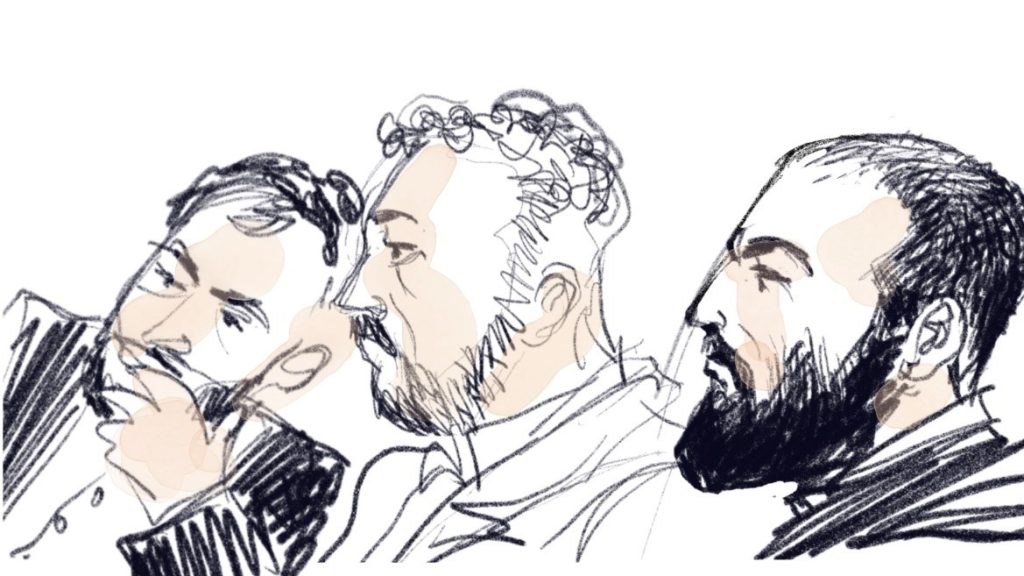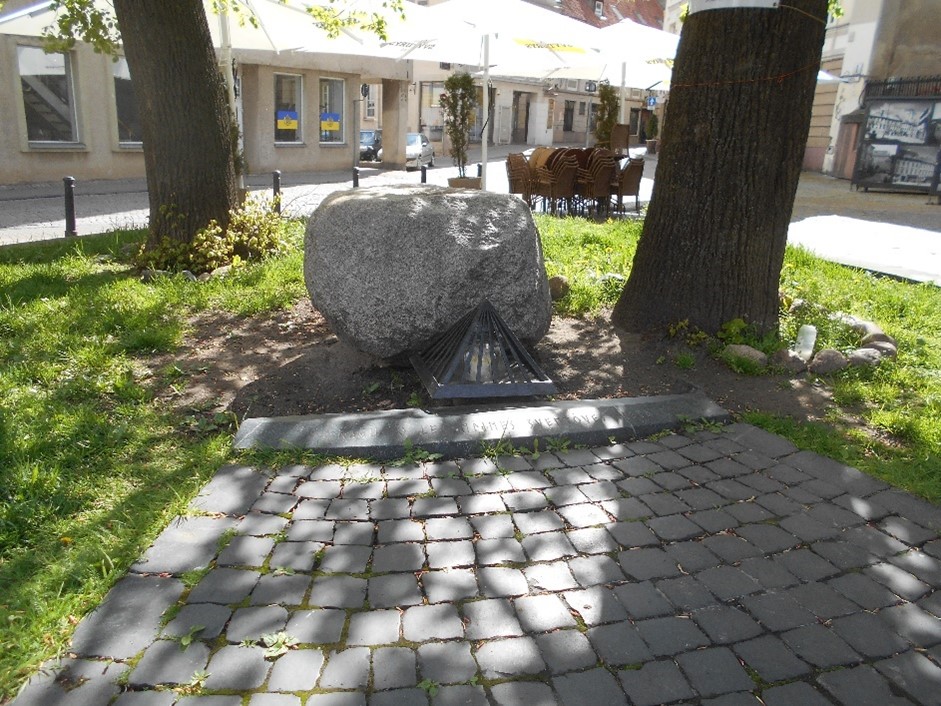…to a workshop of the Next Society Institute and some thoughts on new and old religions
The Next Society Institute
I was recently in Lithuania for a few days, in the capital Vilnius, for a meeting of the Next Society Institute at the Kazimieras Simonavičius University, which I have been a member of for half a year. This is a think tank of a small group of academics who are developing new concepts for different sectors of society (Fig. 1-4). We are planning a series of annual conferences with constructive models for the future.

Contrary to the current trend, which squeezes everything into the Procrustean bed of one true perspective and subordinates everything under one truth, we assume that there are many alternatives, many ways of expressing culture, being human, society, and thus also different futures, “futures” (plural), and not only the totalitarian one future, one truth, one health, one form of politics, one religion, one whatever. The conceptual basis is Niklas Luhmann’s theory of social systems [1].

The name of the university derives from the Lithuanian inventor, mathematician, chemist and engineer Kazimieras Simonavičius (1600 – 1651). He was a general in the Polish army and one year before his death he published the seminal work “De Artilleria”, a book in which he anticipated basic problems of ballistics, artillery, the chemistry of explosives and the design of multi-stage rockets. These thoughts remained groundbreaking well into the 19th century, and Lithuanians are very proud of their scholar, who is sometimes called the Lithuanian Leonardo.


The supposed new old thinking and religion of the Middle Ages
The new stands out from the old, which likes to see itself as the alternatively new, especially in thinking. I would characterize the old thinking as follows: some experts know exactly what is right. Some politicians adopt this opinion and enforce it with more or less clearly perceptible force. The media world washes this truth clean of all shadows into the blinding white, without ifs and buts.
Early religion operated in this way. It gave the dogmatic line. This was also taken over by the secular power. Deviants were identified by the ecclesiastical arm of power – the Inquisition – handed over to the secular power for judgement, and clean remained the world view. Today, fact-checkers, media-present know-it-alls on talk shows and the mob of social media take over the function of the inquisition and locate those who express dangerously deviant opinions and hand them over to the court of public judgement. Which rules according to the accepted and acceptable opinion. No matter whether it is about politics, health, ecology or economics. You don’t even have to have expertise to do this. For the experts, the experts who advise governments, who are present in the media and thus are the only real experts, have found the truth. The media gatekeepers and watchdogs have proclaimed it. Politicians are trying to implement it. And good citizens help them to do so.
This is exactly the hierarchical-elitist model of medieval society, except that instead of divine truth, at the top is what some consider to be the “real”, “scientifically” vouched-for and thus unequivocal truth. To put it another way, this is a pseudo-religious, basically superstitious, or theologically speaking, pagan religion. One could call it materialistic naturalism, or scientism. In it, natural science takes over the function of religion. And because it is unreflective, because those who believe in it don’t even realize that they are adhering to a religion, but think they are only following “the truth”, it is particularly dangerous in my view. Because it does not allow for any alternatives. It does not see its limitations and its dependence on presuppositions. It does not understand that it is built on foundations that it precisely cannot prove to be true and unquestionable by its own means. This has been a commonplace since around the 1930s, when it became clear in various fields that presupposition-free systems of thought cannot exist. I refer you to my Galileoreport [2] and my philosophy of science textbook; I elaborated on this there [3].
The new religion of scientism and its implicit totalitarianism
The idol of this neo-pagan religion is the new trinity of “progress”, “profit” and “material immortality”. Idols are, one finds in the Old Testament, god that demand human sacrifice. This is what the ancient Canaanite religion did, against which Judaism prevailed [4]. So did the ancient Germanic and Celtic religions. Since Christianity became the dominant religion in Europe, human sacrifice has actually been abolished, one would think. Modernity, or what we think of as modernity, has reintroduced them. For human beings are again being sacrificed to the idols of the new-old religion.
In wars, people are sacrificed to a political ideology. Never before have so many people died for the sake of an ideology as in the modern wars since the First World War, or even since the 30 Years War. In the First World War it was the ideology of the fatherland. In the Second World War, it was the blood-and-soil ideology of the Nazis. In the wars since then, it has been the ideology of “Western values” that took millions of lives in Afghanistan and Iraq [5].
Our form of economy leads, contrary to what the prophets of progress would have us believe, to countless people dying, from hunger and other collateral damages of progress, even if some aspects of progress, increasing hygiene, access to clean water, counteract this situation [5].
In the countries of Central Europe, people are sacrificed to “rationalization” and thus to profit: These are the ones who are left behind, who cannot uphold the fast pace and become depressed, drained and burnt out.
We just witnessed how everything is subordinated to the primacy of “public health” in the pandemic. I had mentioned it many times before: the vaccines are associated with deaths that are a factor of 100 to 560 higher than those associated with all other vaccines, and precisely among people in age groups who would have had little to fear from the actual disease [6-8]. I just had an interview with a doctor who is conducting a large observational study on the effectiveness of these vaccines, problems and side effects. He spoke of 200,000 serious and possibly permanent side effects in Germany alone. This fact is being hidden.
In the end, it is the project of human immortality, as Harari has correctly analysed [9], that is the driver of many of these medical developments. If this project is pursued with all rigour, what happens? Then everything else becomes subordinate to the right of the living generation to exist. Then the death of the living generation will be postponed indefinitely beyond the physiological and genetic limit, which is probably somewhere between 120 and 150 years. But there are always new people coming into the world. We don’t need all of them, because artificial intelligence, which is part of these new developments, will take over many tasks. If we combine this development with the primacy of saving the climate ecologically – Zero Carbon Emission – [10], what can be the only consequence, in the medium and long term? We have to come up with something to curb overpopulation. Maybe the one-child policy worldwide, like in China at the time? Or zero children?
Humans will also be sacrificed to this idol of immortality, maybe not now, but sometime in the near future.
Human sacrifices are signs of idolatry and pagan religions. The neo-pagan religion of scientism leads to exactly that in the final analysis. Therefore, it is important that alternative designs, interjections, irritations are thrown into this uniform mash of bad science, false philosophy and media totalitarianism. The interjections by the artists of #allesdichtmachen, which I reviewed in the last blog, are such irritations. Irritations serve to challenge supposed certainties and expose totalitarian interpretations.
Totalitarianism, irritations and satire – a small vignette
Totalitarianism can’t stand either fun or satire. That’s why the reactions to #allesdichtmachen are exposing the truth. I felt reminded of a story from my student days. I was at a conference in the 80s and met a colleague there who had spent a year abroad in Poland, back in totalitarian times with Solidarność uprising and state counter-pressure.
He recounted: as a protest against the controls and roadblocks, critics of the system had put a dead sow in a dinner jacket, put a hat on it and drove around with it in a car until they came to a roadblock. There, the policemen demanded identification from everyone. When the dead sow did not move, they yelled at her. The sow, who was so disrespectful of state power that she refused to show her ID, was finally manhandled, and they tried to drag her out of the car until it dawned on one of the policemen that this was not a subject of state control capable of producing ID ….
So these are irritations. Conceptually, they have the function of breaking down fixed frames of thought, entrenched opinions. The Next Society Institute wants to offer such irritations and new ways of thinking.
Vilnius – old and new
In Vilnius, one can observe how old and new collide. This affects the buildings: old wooden houses give way to new concrete and glass palaces.

Here I also discovered the first neo-pagan shrine of my life. In the middle of Vilnius, on a square next to an Orthodox church. It was consecrated in 2012, and a light has been burning there ever since. It is apparently modelled on an ancient giant stone in the forest about 40 km from Vilnius, which was probably sacred to the ancient Balts. Rainwater, which collects in it, was considered sacred. Now a small replica has been erected in Vilnius. It is dedicated to a deity called Ragutis, who is supposedly the Lithuanian god of beer. According to the Lithuanian Embassy, he is the god of mead and is one of the four main deities of ancient Lithuania (Figs. 6 – 8).



The retreat of the religion of Christianity leaves a vacuum
To me, this is a powerful iconic sign of how the hitherto universal Catholic religion is retreating, leaving a vacuum into which new religions are pouring. Lithuania was Christianized in the 13th century. After an initial success of Christianisation, the next ruler turned back to the old pagan religion for tactical reasons, and princes who opposed him ran into problems. Three who did not go along with this turn back to paganism were tortured and hanged. They were revered as saints and their bodies were hidden and preserved through all the turmoil of history, including the Soviet occupation. Today they are laid out in a glass shrine in the Orthodox St. Nicholas Church.
Religion has an important identity-forming moment. The followers of a religion feel they belong together. They often position themselves against the “others”, who are then labelled barbarians, pagans, esoterics or whatever, thereby devalued and not infrequently given the go-ahead to be shot down. But religions also produce martyrs. These are those who are prepared to lay down their lives or their freedom for the new ideology. The three Lithuanian martyrs Nicholas, John and Eustace, by their sacrifice, made the king who had them on his conscience turn back and end his life as a Christian monk. This sealed the victory of Christianity over the old religions in Lithuania.
The neo-pagan scientistic religion: its rituals, confessions, bibles
The neo-pagan scientistic religion also has its martyrs, the initially unrecognized heroes of science, whose sacrifices and sufferings must then be framed accordingly. Galileo, for example, who in fact and truth suffered less than is generally assumed [11, 12] and was himself responsible for many of the things that happened to him; Bellarmin and the Jesuits, for example, were very sympathetic to him. If Galileo had not portrayed him as a fool in his dialogues, he would have had fewer problems when Bellarmin finally became pope and returned the favour [13]. Popes, after all, are only human.
The scientistic religion has its rituals, priests and popes: the award ceremonies, Ted Talks, editors of the high-ranking journals, chairmen and members of the academies. And it has its silent creeds. That matter is the only real thing. That our consciousness emerges from matter, that is, it is generated by the brain. That after death everything is over. That there can be no final justice, and thus no transcendent anchoring of morality. The 10 Commandments thus become social convention. Therefore, what we declare to be moral is moral. That can change, as we know.
She has her bibles. Steven Pinker’s book “Enlightenment Now”, is one of them [14]. I described this in more detail in a review essay [15]. It has its missionaries. Bill Gates is one of them. He describes Pinker’s book as “my new most favourite book of all times” (on the Penguin paperback edition). The Brights movement is another group that, according to its self-description on the internet, wants to displace religions from their ancestral privileged places in our society and put the naturalistic-scientific world view in its place. This is another term for what I called neo-pagan scientism above. I outlined these connections a while back in an essay [16].
The mindset behind scientism is basically totalitarian, even if it pretends to be outwardly modern and enlightened. For it demands that there is only one clearly recognizable truth and a maxim for action that can be clearly derived from it. And it subordinates all social, scientific and political discourses to the primacy of a scientific way of thinking.
It comes in the guise of the new. But it is basically old-new, new-pagan. It turns the wheel of thought of intellectual history and the wheel of devotion of religious history back to pre-Enlightenment and pre-Christian times.
The New? Mysticism for all?
What would be the new new? Christian religions, as they present themselves, are apparently passing the baton, at least in our European culture. Christianity is losing its power and conviction, not least because many of its representatives are themselves implicitly, and presumably without realizing it, adherents of this neo-pagan scientistic religion, the scientific world view. The simple replacement narrative of the old religion with the new, secular world view is too cheap, as Charles Taylor has convincingly and impressively pointed out [17].
A spiritually renewed Christian or other religious culture in which, as it were, “mysticism for all” becomes the standard, that would be an alternative. My old Carthusian mystic Hugh de Balma, whom I translated, had something like this in mind as early as 1270 or thereabouts [18]. This has not yet become reality, and is a bold vision of the future that I personally find very sympathetic. Eastern religions and mystical Islam also have such a vision.
Mysticism is inherently anarchistic. It does not allow itself to be dictated to, by anything or anyone, but those who follow it follow their inner compass. It used to be called “conscience”. Mysticism is inherently innovative. Because it tries to give space to the “spirit”, which, as we know, blows where it wants. And from this, completely new, undreamed-of paths can emerge. Incidentally, this is what this path has in common with real and good science. For a mystically mediated insight, an inner spiritual experience, is very similar in structure to an intellectual-scientific clear-sightedness, as I explained in my penultimate blog.
An intellectual-scientific alternative is multipolar thinking, which precisely refuses to fall for a supposedly true, scientific narrative without alternatives. This is thinking in multiple possibilities and different scenarios and spaces of thought. This thinking, much like a spiritual-religious person, is aware of the fact that we can never hold the truth and therefore should respect the possibilities, the ways, the expressions of others. Similar to the mystic, such a thinker will always cause irritation because he or she questions the supposed truths and contributes new perspectives that break down totalitarian dogmatism. The unconditional openness of the discourse space is the arena of this thinking.
As a Buddhist patriarch said when asked about the essence of the dharma, “No holiness – Vastness.”
Sources and literature
- Luhmann N. Soziale Systeme. Grundriß einer allgemeinen Theorie. Frankfurt: Suhrkamp; 1984 1984.
- Walach H. Beyond a Materialist Worldview: Towards an Expanded Science. London: Scientific and Medical Network; 2019.
- Walach H. Psychologie: Wissenschaftstheorie, philosophische Grundlagen und Geschichte. 5. überarb. Aufl. ed. Stuttgart: Kohlhammer; 2020, orig. 2005 2005.
- Quigley C. The Evolution of Civilization: An Introduction to Historical Analysis. New York: Macmillan; 1961.
- Mausfeld R. Warum schweigen die Lämmer? Wie Elitendemokratie und Neoliberalismus unsere Demokratie und unsere Lebensgrundlagen zerstören. Frankfurt: Westend Verlag; 2018.
- Walach H, Klement RJ, Aukema W. The risk-benefit ratio of Covid-19 vaccines: Publication policy by retraction does nothing to improve it. Clinical and Translational Discovery. 2022;2(1):e35. doi: https://doi.org/10.1002/ctd2.35.
- Walach H, Klement RJ, Aukema W. The Safety of COVID-19 Vaccinations — Should We Rethink the Policy? Science, Public Health Policy, and the Law. 2021;3:87-99. https://www.publichealthpolicyjournal.com/general-5
- Walach H, Ofner M, Ruof V, Herbig M, Klement RJ. Why do people consent to receiving SARS-CoV2 vaccinations? A Representative Survey in Germany. Research Square. 2022. doi: https://doi.org/10.21203/rs.3.rs-1216502/v1.
- Harari YN. Homo Deus. A Brief History of Tomorrow. London: Vintage; 2017.
- Gates B. How to Avoid a Climate Disaster. The Solutions We Have and the Breakthroughs we Need. London: Allen Lane; 2021.
- Shea WR, Artigas M. Galileo Galilei. Aufstieg und Fall eines Genies. Aus dem Englischen von Karl H. Nicolai. Darmstadt: Wissenschaftliche Buchgesellschaft; 2006.
- Numbers RL, editor. Galileo Goes to Jail and Other Myths about Science and Religion. Cambridge, MA: Harvard University Press; 2009.
- Fischer K. Galileo Galieo. Biographie seines Denkens. Stuttgart: Kohlhammer; 2015.
- Pinker S. Enlightenment Now: The Case for Reason, Science, Humanism, and Progress. London: Penguin; 2018.
- Walach H. Schöne neue Welt? Ein Essay über Steven Pinker (2018) Enlightenment Now. Aufklärung und Kritik. 2019;26(2):196-208.
- Walach H. Kulturkampf 2.0: Wie deuten wir die Welt und wer ist maßgeblich. Zeitschrift für Anomalistik. 2021;21(1):185-94.
- Taylor C. A Secular Age. Cambdrige, Ma: Harvard University Press; 2007.
- Hugo de Balma. Die Wege nach Sion trauern: Viae Sion lugent, auch überliefert unter dem Titel “Mystische Theologie”. Übersetzt, eingeleitet und erläutert von Harald Walach. Münsterschwarzach: Vier Türme Verlag; 2017.

